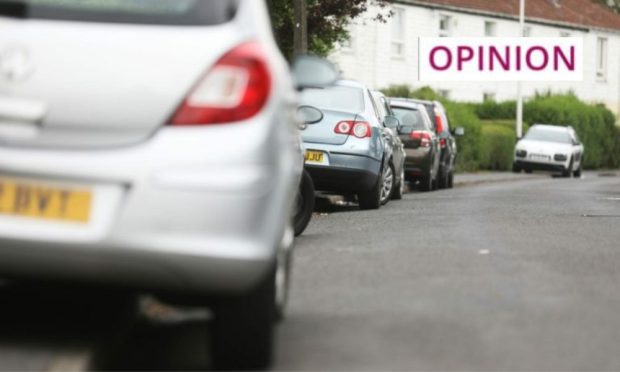Courier readers back the ban on pavement parking, with the majority of those who took part in our online survey saying they supported the new plan.
The ban came into force across Tayside and Fife this week although councils are taking different approaches with how quickly – and harshly – the new rule is implemented and enforced.
Instinctively, I, like the majority of Courier readers, support the plans.
As a non-driver (though not for want of trying) the lack of consideration that some drivers have for pedestrians boils my blood.
The walk to school with my daughter each day only takes 15 minutes.
But it’s rare that we don’t encounter the bad manners of car drivers in that time.
‘Hack through the edge – or walk on the road’
There’s one road in particular that always raises my blood pressure. It’s just off a big road, in a posh bit of town.
The huge houses that line it have driveways with room for at least two cars.
One of these houses has a huge hedge in front of it, at least 15ft high.
But the rich folk that live in that house don’t bother to maintain it so it also grows outwards – and takes up half of the available walking space on the pavement.
More often than not, there is a car parked right on the pavement outside.
That leaves my daughter and I with two options: either pack a pair of shears for the school run and hack our way through the hedge, or walk on the road until we get around the car.
Accessibility on pavements is a huge issue.
In Scotland, the car is king and parents with buggies, wheelchair users and the visually impaired are just expected to adapt.
Nine times out of ten, that means walking on the road, while the oh-so-delicate Range Rover is tucked safely out of the way of oncoming traffic.
Common sense approach to pavement parking ban
Of course, the pavement parking ban must be applied with a degree of common sense.
A blanket ban would unfairly penalise those living in built-up areas without the luxury of a private driveway.
In Dundee, there is a consultation underway to explore the possibility of exceptions for certain streets.
This is entirely sensible. Car-free pavements would be a beautiful thing to behold but in many areas that’s not a realistic expectation.
My wee street is really narrow and there’s no option for my neighbours other than to take up a bit of pavement space.
If I ever pass my driving test, I’ve already decided I’ll leave my car in a small carpark nearby, rather than trying to squeeze yet another vehicle into the crammed space.
That’s an easy choice for me to make but it isn’t an option for my elderly neighbours who need to be able to park directly outside their homes.
In some areas, there will be a £100 fine for people who flout the new rules.
That is a considerable sum for most people in these difficult economic times.
There is a risk that councils might see the ban as a way to squeeze money out of those that ill-afford it, to fill up their own dwindling coffers.
It would be best to keep the heavy fines for those most egregious offences that we all see daily.
In an ideal world, councils would invest any money they bring in from pavement ban fines into initiatives that make walking as smooth and easy a process as driving.
That means many more pedestrian crossings and better lighting in public spaces.
And as we head into winter, councils might also want to consider how they can prepare for the big freeze ahead.
It’s no use clearing pavements of cars if they’re going to be ungritted and at the mercy of the treacherous ice we have to endure every year.













Conversation